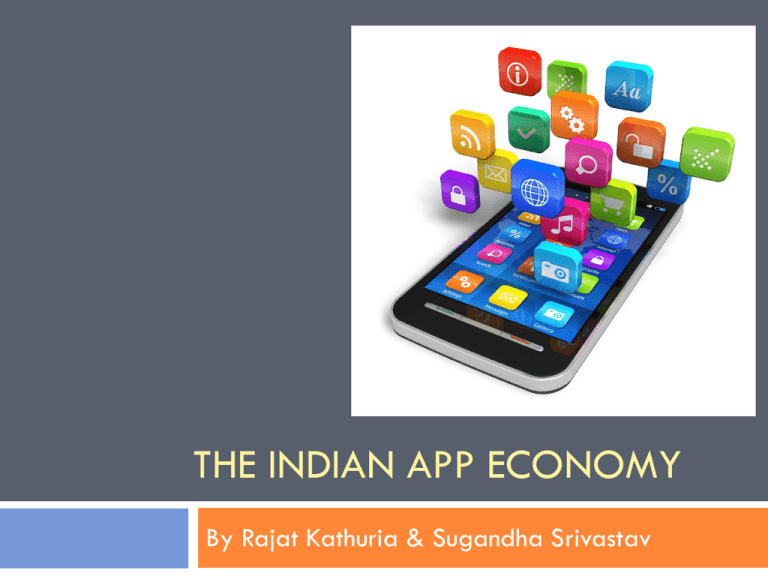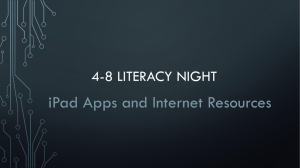The Indian App Economy - Indian Broadband Policy and Regulatory
advertisement

THE INDIAN APP ECONOMY By Rajat Kathuria & Sugandha Srivastav India’s App Economy: Currently an Urban Tale Google: Our Mobile Planet India (2013) But with Enormous Potential... Total Worth of Indian App Economy • 150 million USD App Downloads per Month • 100 million App Developers • 300,000 9% 10% Smartphone Feature Phone 81% Multimedia Phone Source: Nielsen Mobile Insights (2012) Projected Revenue from Paid Apps in India (rupees crore) 89% percent increase in the number of smart phones in urban India from 2012 to 2013. Total: 51 million smart phones The Second Phase of a Telecom Revolution: Content India’s teledensity is 73% will reach 100% by 2015. Mobile Phones have penetrated nearly all income strata. Next Step: Exploit this connectivity to address India’s high service deficit. ICT for Development e.g. MOOCs, m-Health, m-banking, egovernance etc. Why apps in ICT for Development? Apps are intuitive to use due to their single-purpose nature . Often less-data intensive than internet sites. Will gain prominence as smart phone penetration rises. Have the ability to create a significant number of jobs. The App Economy’s 3D Framework Source: Made by the Authors 1st D: How to Bolster App Development Weak user interface design App developer teams in India must employ not only software engineers but also design professionals and psychologists so that an in-depth understanding of visual aesthetics and user behaviour is achieved. Lack of locally relevant content. Need local app distribution platforms that provide 70-30 revenue shares to developers. Network coverage and capability must improve within the interiors of the country where the demand for highly localised apps is greater. App developers will need to collaborate with OEMs to ensure that localised apps, which may require hardware support for Indic scripts, function well across a variety of devices. Government can offer technical and monetary support to apps developers and distributors who are designing apps that serve a public good. Telecom operators may have a role to play, provided they offer competitive revenue shares to app developers, in facilitating mobile payments since they cater to a large prepaid segment. 2nd D: How to Boost App Distribution The problem: The most popular app distribution platform in India is Android’s GooglePlay. International app stores do not lend themselves to the easy discovery of highly Indiaspecific/regional content. 3% 5% 1% Android Symbian 8% Windows Phone Windows Mobile 21% 62% RIM iOS Share of Purchases for India, Fieldwork: Sept-Oct. 2012 Source: Nielsen Informate Mobile Insights Need business model innovation on the app distribution side. Case Study: AppsDaily AppsDaily sells its own apps through physical outlets that are located across 140 cities in India. Circumvents unfavourable mobile-payment regulation by allowing payments in cash. Makes the process of obtaining apps easier for those who are less digitally literate or aware by having physical attendant at stores. 3rd D: How to Unlock Latent Demand Increase: Digital Literacy Advanced Data User 35% 51% SMS/Voice User 2% 14% 6% 12% 84% 83% Gender Parity Awareness Voice Only User 6% 26% Male 20 80 68% Female 39 47 55 61 53 45 China USA 13% India China USA UK Source: Mobile Youth Around the World, Nielson (2010) India UK Source: Mobile Youth Around the World, Nielson (2010) Business Model Innovation in Monetisation The Freemium model Subscription model In-App Purchases Advertising In-App Advertising Improving the Overall App Ecosystem Seed capital Network Infrastructure Consumer Devices Operating System Policy Framework Socio-Economic Condition Innovation Penetration Affordability Fragmentation M-Payment & Spectrum Efficiency Usage For more details on the above, please read the report! Bottom Line Mobiles for Entertainment Mobiles for Development India can do better & apps can help. M4D per million unique mobile subscribers Source: GSMA Intelligence Country Overview: Sri Lanka Data: MDI Products and Services tracker, MDI Analysis But All Stakeholders Will Need to Contribute as shown in 3D framework. The Way Forward & Conclusion Focus will be on urban market till saturated – low-hanging fruit. Cater to the domestic market by focussing on localised content. Aim for international competitiveness through innovation: The ability to search for in-app content without downloading the app. Apps that allow for a new degree of device customisation. Apps that replace previously paid-for-services. The app economy must be strengthened by increasing consumer awareness, enabling the growth of local app distribution platforms and incentivizing app developers to create locally relevant content so that apps can penetrate new regions. These initiatives will only be successful if network coverage and capability increase as well. One Small Presentation is Not Enough Contact us for more information! Rajat Kathuria: rkathuria@icrier.res.in Sugandha Srivastav: ssrivastav@icrier.res.in Thank you!





